In the last five years, California has spent nearly $1 billion to change what’s in people’s garages.
A major portion of the Golden State’s greenhouse gas emissions comes from transportation — diesel-spewing trucks and buses, but also reliable old sedans or SUVs — so as California takes in billions in revenue from its first-in-the-nation cap-and-trade policy, it’s been helping Golden State residents make the switch.
Related: Oregon Legislature Treads Carefully Toward Pricing Carbon
The state has spent at least $929 million of the money helping Californians buy more than 200,000 electric vehicles, subsidizing zero-emission buses for transit systems and cleaning up freight transportation, among other things.
Today, Oregon looks like it's on the verge of following California's lead and becoming just the second state to adopt such a sweeping program. House Bill 2020, which would institute cap and trade, is widely favored by legislative leaders and Gov. Kate Brown.
But Oregon’s ability to help its citizens go electric is very much in question.

Electric car charging stations are seen at the Residence Inn by Marriott in Northeast Portland on Thursday, Feb. 28, 2019.
Moriah Ratner/OPB
Because of a provision in the state constitution, most of the money Oregon currently expects to bring in under a cap-and-trade program could be off-limits for things like electric vehicle rebates, electric charging stations, zero-emissions buses and more — initiatives that are mainstays of similar programs in California and Quebec, and considered powerful drivers of emissions reductions.
Instead, most money generated under the cap-and-trade plan would be limited to road and highway projects, many of which are less impactful in reducing emissions, according to the Oregon Department of Transportation.
As Oregon economist Mark McMullen put it last year: “Oregon doesn’t necessarily have the freedom to use revenue that’s derived from carbon taxes and carbon fees the way some other states do.”
Curbing Pollution — And Raising Money
As envisioned, Oregon's cap-and-trade system would create a massive new source of cash to help the state adapt to climate change and transition into a cleaner economy. By charging large polluters for every ton of greenhouse gases they emit, the state's Carbon Policy Office estimates the state could take in $550 million from the program in 2021.
Total emissions allowed in the state would reduce over time, theoretically getting Oregon to 80 percent below its 1990 emissions levels by 2050.

Morning traffic on Interstate 84 is seen on Thursday, Feb. 28, 2019.
Moriah Ratner/OPB
The sticking point comes in how polluters are regulated. Large electric utilities get free credits until 2030 under the current proposal, and many industrial facilities would receive some freebies to help them remain competitive.
Automotive fuel distributors, on the other hand, would not receive any free credits under the current proposal. That's created an expectation that two-thirds or more of cap-and-trade money, around $350 million a year, will derive from transportation fuels. Under a constitutional provision voters approved in 1980, money raised by fuel taxes goes into a State Highway Fund and must be spent "exclusively for the construction, reconstruction, improvement, repair, maintenance, operation and use of public highways, roads, streets and roadside rest areas …"
In other words, new “auxiliary” lanes on highways or dedicated lanes for buses could be paid for with the money, but helping put zero-emission cars and buses onto those lanes probably isn’t in the cards.
Related: 'Convince Us If You're For Real': Lawmakers Reopen I-5 Bridge Talks
A smaller chunk of prospective revenue from cap-and-trade would be less restricted in its use, but also subject to a wide array of competing demands, from home weatherization to job training programs.
“Sounds like your constitution was written by the oil industry,” said Kathryn Phillips, director of Sierra Club California. “That’s the kind of thing the oil industry would love.”
Phillips’ group has some big qualms with how cap and trade has been developed in California — it believes that the state created a system where polluters are able to get off too easily. But one thing the Sierra Club does support, Phillips says, is the money California has spent on helping its citizens travel in more environmentally friendly ways.
“We believe very much that electric vehicles [and] electrifying the vehicle fleet is important and a place that you can put money and you actually get real reductions in greenhouse gas emissions,” Phillips said. “The co-benefits are that you actually get cleaner air. So that’s been one place where we’ve said, ‘Put the money.’”
From 2013 to 2018, California spent more than a half billion dollars helping citizens purchase electric vehicles, according to the state’s Air Resources Board. It’s helped fund zero-emission trucks at state ports, and car-sharing fleets made up of electric vehicles.
The largest recipient of cap-and-trade funds to-date is an electric, high-speed rail system California is developing.
“Because vehicle emissions are the leading contributor to [greenhouse gases] here, a large portion of the proceeds go to reduce those emissions,” said Dave Clegern, spokesman for the California Air Resources Board.
Quebec has also spent heavily to electrify its transportation system, according to the Canadian province’s environmental ministry, some $334 million since 2013.
Oregon Goes A Different Direction
In Oregon, about 40 percent of greenhouse gas comes from transportation — the single largest driver of emissions — and the state is headed in the wrong direction.
A recent report from the Oregon Global Warming Commission suggested that emissions are going up statewide, with transportation emissions driving much of the rise.
More people drive SUVs and light trucks in the state than they did just six years ago, according to ODOT, and the long-term outlook doesn’t show signs of improvement. The same goes for older vehicles, which have lower fuel efficiency than new models.
“Unless we’re a lot more aggressive in our policies and investments, we don’t expect to see a lot of long term gains,” Amanda Pietz, an ODOT program manager, told lawmakers in November.
In 2017, Gov. Kate Brown set a goal to get 50,000 electric vehicles operating in Oregon by 2020. As of today, there are a little more than 22,200, though state officials say their popularity is growing.

Electric car charging stations are seen at the Residence Inn by Marriott in Northeast Portland on Thursday, Feb. 28, 2019.
Moriah Ratner/OPB
Pietz and others argue progress is possible, even if Oregon can't use cap-and-trade money to electrify. Money in the state's restrictive highway fund can be used on bike or bus lanes, on traffic management tools to ease congestion, and on roadway improvements that make it easier for people to walk instead of drive. ODOT says adding auxiliary lanes to highways, like it plans to do in a controversial project slated for Portland's Rose Quarter, could qualify, too.
Oregon also has a list of eligible projects to help the state adapt to the effects of climate change — think replacing culverts overrun by flooding or planting trees to prevent landslides on to roads.
“Constraint is always difficult, but at the same time I will say that the constitutional restriction makes us more creative,” says state Sen. Michael Dembrow, D-Portland, a key architect of the cap-and-trade proposal. “Culverts, bridges, hillsides are not sexy until they fail. When a culvert fails, it’s terrible for fish. It puts a road out of commission for a period of time.”
Dembrow and other lawmakers also mention a point that will almost certainly be tested if a cap-and-trade law passes as expected: Not everyone’s so sure that cap-and-trade money would be limited in its use by the state constitution.
Related: Report: Economic Benefits Of Cap And Trade Will Outweigh The Costs In Oregon
“What I tell my constituents is we’re legislators, not judges,” said state Rep. Karin Power, D-Milwaukie, at a recent hearing of the Legislature’s Joint Transportation Committee. “The question has not been asked of our Oregon Supreme Court on this issue.”
Power and Dembrow point to a 2018 Oregon Supreme Court ruling that upheld the state's decision to use a new vehicle sales tax on rebates for citizens who buy electric vehicles. Up to $12 million a year from the tax goes into rebates. The state has received more than 3,000 applications for that money, to date.
The Supreme Court ruling, Dembrow said, suggests to some “that maybe it’s not so cut and dry,” and that cap-and-trade revenues might be available for a wider set of purposes than officials currently assume. In order to settle any legal challenge arguing as much, the cap-and-trade bill currently includes a provision sending lawsuits directly to the Supreme Court.
Many believe such a challenge, when it comes, is unlikely to persuade the court. That means Oregon may have to look elsewhere if it wants to help convince Oregonians to transition to cleaner transportation.
“We’re going to need to invest heavily in transportation electrification,” says Jeff Allen, director of the industry group Forth, which touts electric vehicles. “And if it turns out we can’t use revenues from this program, then we’ll have to find another way to do it.”
